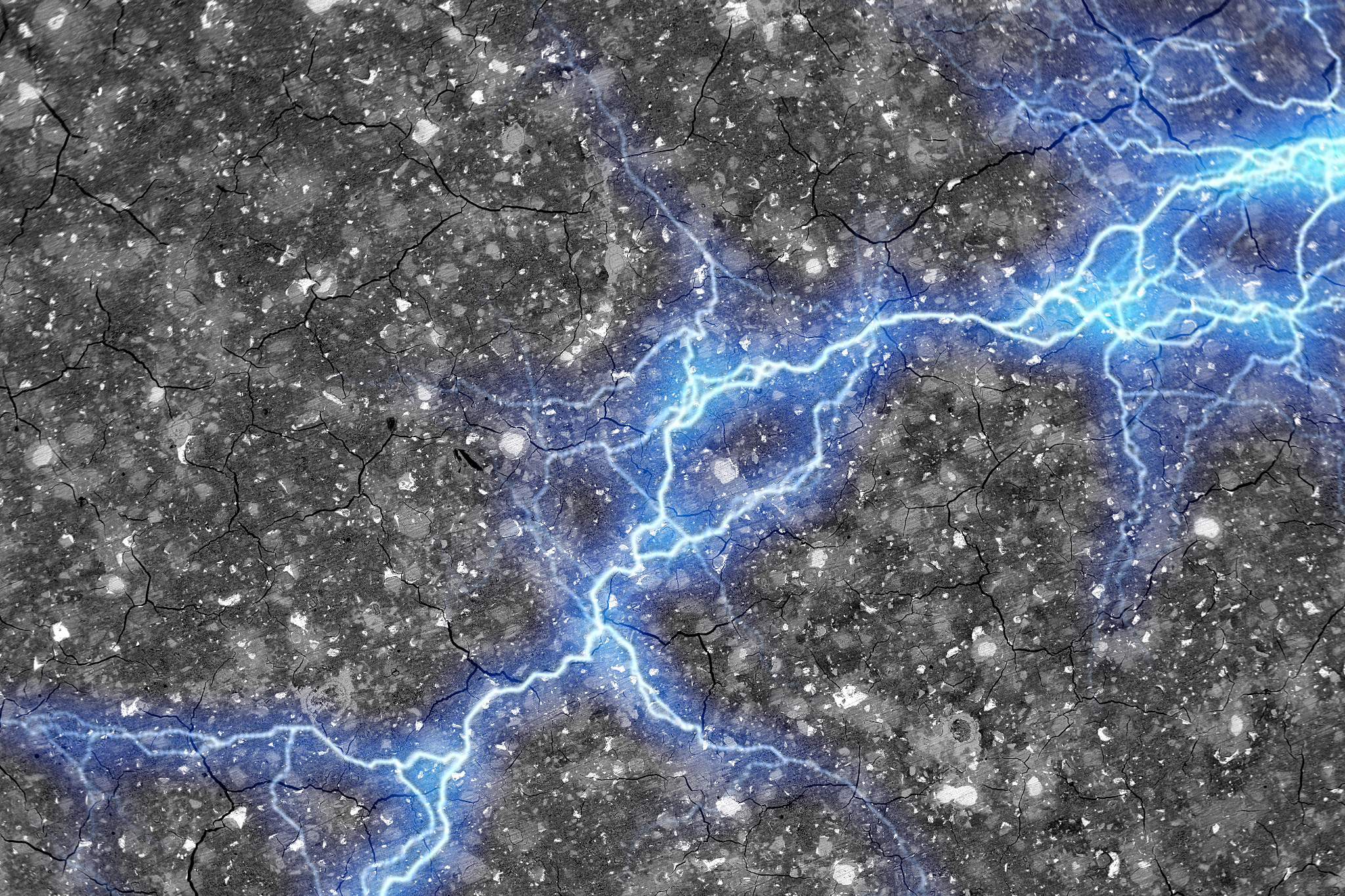A 2023 study at MIT made this discovery, which could be a boon for storing electricity.
The team calculated that a block of nanocarbon-black-doped concrete that is 45 cubic meters (or yards) in size — equivalent to a cube about 3.5 meters across — would have enough capacity to store about 10 kilowatt-hours of energy, which is considered the average daily electricity usage for a household.
3.5 cubic meters of material ought to be enough to make quite a comfy house
There is a tradeoff between the storage capacity of the material and its structural strength, they found. By adding more carbon black, the resulting supercapacitor can store more energy, but the concrete is slightly weaker, and this could be useful for applications where the concrete is not playing a structural role or where the full strength-potential of concrete is not required.
They talk about making roads with the material, but I suspect electrical posts (utility poles) could also be made of this, which would certainly last much longer than roads and be cheaper to maintain and fix
I wonder if you could make a 1m thick foundation of this stuff beneath each house which works as a sort of battery for the house in case power goes out.
That’s neat, but a typical house foundation only uses like 10-15 cubic meters of concrete. Even a flat 8” slab for a 40’x40’ house (huge footprint!!!) uses 30 cubic meters of concrete. Only 2/3 the 45 they say.
Concrete is also pricey already ~$250 a meter (CAD, US is close).
A lot of shaky stuff in here that has a long way to go before it makes it out of the lab.
3.5 cubic meters of material ought to be enough to make quite a comfy house
OP, a 3.5 m-wide cube is not 3.5 cubic meters. That’s the size of a decently large shed… Of solid concrete.
would have enough capacity to store about 10 kilowatt-hours of energy, which is considered the average daily electricity usage for a household
No mention in the article about round trip efficiency, self-discharge rates / storage duration, etc.
Storing 10 kWh doesn’t mean much if it loses much of that to internal losses, leakage into the environment, etc., before you can use it.
Capacitors generally tend to be designed to store very little energy but can charge/discharge repeatedly at a high rate. Is this designed to discharge quickly? If so, what happens if someone touches the giant Borg cube in your yard?
Concrete is also prone to cracking, which last I checked, is not good for electronics.
That said, this is an interesting concept, and if it can perform at a useful level / scale, I could see industrial uses for large systems with high peak loads / energy recovery / regenerative braking, as a cost effective way to smooth grid loads, but probably wouldn’t expect to see it in use at people’s homes for a loooong time.
Less “you can make a super capacitor at home”, more “innovative material uses may one day make super capacitors more cost effective for certain applications, if it can be scaled out of a lab”
Yeah a 3.5m cube is 3.5^3 cubic meters. You gotta change the number the same as the unit. Honestly KL might be better than m^3 for intuitiveness
It is cool, and yes the prototype they made is the size of a coin battery. They made three 1v “super capacitors” and linked them together to light a 3v LED.
That said, my only question was should they ever get it to be able to store and discharge 10kW, wouldn’t it necessarily all discharge at once? Like, it’s not a battery - but that’s a small problem after they’ve solved the big ones.
Failed electrical engineering major here - it turned out I was built to be a scientist, not an engineer, but it took a year of EE classes to figure that out.
Regarding energy storage, capacitors aren’t much different than batteries, but they can charge/discharge faster, have lower energy density (units of stored energy per units mass), and self-discharge faster, hence why they aren’t used in place of batteries. For something where weight and volume aren’t an issue and with no need for long-term storage, like a solar-equipped house, a huge cap would be a great option. I’m trying to figure out how to build one of what’s described it the article now.
The rate at which a capacitor discharges varies just like a battery, proportional to the resistance of the circuit. The reason most folks associate capacitors with “shorted terminals go boom” is the maximum rate of discharge on a capacitor is much higher than a battery, plus some capacitors operate at a much higher voltage than is practical for a battery, increasing the likelihood of generating a small arc. Shorting the terminals with a conductor makes a low resistance circuit so it just dumps its charge, whereas a battery would max out at a much lower rate, typically making a toasty wire versus a vaporized or melted wire.
Where is the daily usage 10kWh? Americans use 25kWh on average per day. I personally used around 20kWh per day last year.
A modern LiFePO4 battery will outperform this in every way possible. This is cool and all, but it’s far from being practical, so why should we know exactly?
Also about the utility poles, just a little life hack for you: Most large scale older systems are highly optimized. If you ask yourself “Why don’t they just…”, the answer is probably a dozen reasons. Utility poles being made the way they are is most likely the optimum solution. The scale is so large, even small improvements add up, so you can be pretty sure the current solution is optimal.
Cement is also not a good material, cement production accounts for 4-8% of all CO2 production. We need to use it less, not more. Putting in a huge block of cement in your backyard would be a disaster, just buy a small cheap reliable LiFePO4 battery.
Cement is also not a good material, cement production accounts for 4-8% of all CO2 production.
I thought that was concrete?
Because of the cement used to make the concrete yes. The cement accounts for most of the environmental impact of concrete. But doesn’t account for the impact by destruction of habitat from extracting the sand and rock (and water for that matter).
The cement industry as a whole is responsible for about 10% of all the human released CO2.
There is a Wikipedia page about it if you are interested:
https://en.wikipedia.org/wiki/Environmental_impact_of_concrete
Cement is one ingredient in concrete, the other is sand and aggregate, which just require access to really.
I think the goal is to use it for the concrete slabs that form the foundation of every building. So, no extra material added, but only applicable for new buildings. No extra rare earth mining needed either. I think it’s pretty cool, and we should know about that possibility.
A “green” house could have that in the foundation and a solar roof and be nearly self sufficient.
This is just marketing talk, what you suggest would not be possible. The concrete mix to create a foundation for a house is very precise and you can’t alter it without messing up critical properties. It also isn’t clear if something in the shape of a foundation would even work as a capacitor.
It’s a couple of guys doing cool stuff in a lab, it’s nowhere near a practical application. I hate these kinds of media hyped articles where a small scale preliminary lab result is just extrapolated into a fairytale result.
From what I read in the paper, it is unclear how this will scale at all. They created a capacitor and stored tiny amounts. In theory by using more material, you can store more energy. But that doesn’t really work because the electrodes used have a maximum amount of material they can affect. So you would need to put in a whole bunch of electrodes all over the place to make it work.
In the end it would make a really complicated, convoluted battery. With the only upside is it “only” needing cement, carbon black and water (plus a whole bunch of other stuff they didn’t list in the article but is in the paper). With how little materials you need for a LiFePO4 battery, I don’t know how this would ever compete.
Read the actual paper, it doesn’t make the claims the marketing blurb does. And IMHO those claims aren’t backed up by the paper at all.
Concrete has different spec ratios, spec a higher psi concrete, and allow the lower end strength.
Commonly done when you want to use accelerators or retardants already.
Edit

Edit 2, an even better one for making your own in a mixer, it’s not as exact as you think.

Yes, now try adding carbon black and slicing the material into layers of conductive zones (the cement) and insulating layers in between (at that scale probably some kind of plastic would be required). The ability to support a whole house and be stable over time would be destroyed by this.
Adding carbon black in the amounts required to make it work well would turn the concrete into dust, they said this in the paper. So the amount you can add is pretty low, and it will still reduce the strength, so you would need to compensate. However adding sand and stone also messes with the ability for it to work as a capacitor. The little capacitors they made themselves contained no sand and no stone and they called it “concrete-like”. This then got turned into being “integrated” into concrete foundations in the marketing, but the researchers probably didn’t mean actually building a foundation using this material.
And like I said, you need the insulating layers, it isn’t a magical material. It’s just a cement being made slightly conductive using carbon black. Then alternating conductive and insulating layers creates a capacitor, like all capacitors ever are made.
Plus you need to integrate the electrodes all over the place, I don’t know how you would do that and still have the concrete be load bearing. It would be like a Swiss cheese full of holes all over the place.
You mean the carbon black that’s already used as a dye….?
And can already be accounted for with adjusting the spec mix…?
Come on buddy, you can’t just read a paper and pretend to be a professional on a topic. It’s not hard to adjust mixture strength for admixtures, it’s done every friggen day.
They are talking about way higher amounts, tens of procents. And good luck convincing any structural engineer to add dye to a load bearing piece. It’s fine for something like a driveway or fancy decorative pillars, but not a foundation.
And this was in the paper, they tested how far they could go before the cement mix wasn’t good any more. And to iterate: they did not use concrete, it was just cement along with a lot of additives and the electrodes. It’s not even clear concrete could work, or if the sand and stone would disrupt the ability for it to work.
Plus the layering required of alternating conductive and insulating layers and the electrodes. Or are they magically solved by changing the mix?
People dye their foundations all the time, clearly you have no education or experience with the materials.
You should probably stop trying to speak authoritatively on a subject you clearly know nothing about.
A couple of guys doing cool stuff in a lab is how progress is made. If we stopped people like Tesla, Newton, and Faraday because “candles are readily available and whale oil is a natural resource” we wouldn’t have any of the tech we take for granted today.
This discovery is super cool, like imagine its applications in walkable cities where the entire pedestrian pathway is also storing energy from wind and solar
Comparing something done in 2023 with anything done hundreds of years ago is a bit of a false equivalence.
Calling this a “discovery” is also a bit of a stretch. What did they discover exactly? Putting carbon black in stuff makes it conductive? We knew that. Putting alternating layers of a conductive material and insulators creates a capacitor? We have known that for over 250 years.
I’m not saying what they did isn’t cool. Or that we shouldn’t let students do cool research projects like this. By doing the research, putting in the work, we can advance our knowledge. I’m all for investigating this further and see where it leads.
But let’s not get carried away and just extrapolate a marketing blurb into infinity. Going from we got a led to light up in a lab to “imagine its applications in walkable cities where the entire pedestrian pathway is also storing energy from wind and solar” is maybe a bit of a leap without anything to back it up.
I realize it’s the job of the university’s marketing department to hype stuff up and make it look good for investors. But they often go way too far. Making leaps that are way beyond what the research showed, well into the nonsense realm.
They found a way to create a high surface area capacitor made largely from abundant resources. Even a proof of concept is a discovery. We may not see it in practice in our lifetimes because science and industry take time, but that doesn’t diminish the value at all.
Why is this a false equivalence? I’m not saying this is the next Faraday. I’m comparing contemporaries. You can’t know what technologies will make what kind of difference in the future, but there’s no harm in being excited about our interested in them and their possibilities. I think my comparisons are fair, especially if you consider the technology of each contemporary era. What about Turing? He created a mechanical computational machine and extrapolated the future possibility of machines that could mimic human communication. That is absolutely an edge case assumption given the technology of the time and yet here we are with LLMs running rampant.
as much as I’d love a giant concrete cube adorning my yard, I doubt most people share my peculiar taste
I’ve been looking for an excuse to get a sphere tho
ooh fancy!
Tired AF of these non YSK posts.
Nobody needs to know this. Nobody.
Especially when it’s an unrealized technology that has been “calculated” to be possible.
Knowing this makes life easier for practically nobody, so it doesn’t really fit this community.
It is cool, though. I think it would make a good Today I Learned.
Speak for yourself, I might make one!
gonna use this in my death star.
I hope you do, and show it off when you’re done!







